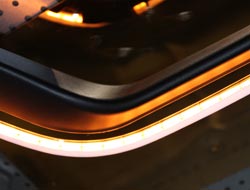Infrared Emitters for Reproducible, Three-Dimensional Heating Processes

QRC® Infrared emitters have a nano reflector of quartz material and can be shaped exactly to match work pieces. Copyright Heraeus Noblelight 2010<br>
Head restraints, roof coverings, or arm rests – a car interior consists of very many formed parts. Mostly, these consist of a plastic support part covered with textile materials, leather or more plastic. The edges of these interior décor features are then folded over and stuck together. The associated heating processes must usually be carried out in relatively restricted space in a very short time.
QRC® infrared emitters, which are shaped to follow the contours of the parts to be heated, transfer heat rapidly, without contact and in a targeted manner and are themselves very heat-resistant. In addition, in very hot locations, they do not create hot- or cold-spots, the heating is homogenous and the result is reliable.
Heraeus Noblelight is showing QRC® infrared emitters at the K Exhibition in Duesseldorf from 27 October to 3 November.
Support parts of plastic or natural fibre polypropylene (PP) are covered with décor materials in textiles, leather or other plastics. The excess length of cover material is then thermally fixed by being folded over and glued. Usually, this takes place with an adhesive, which is activated with heat at temperatures of around 80ºC. When this fold over is stuck together without adhesive, the plastic is melted at 130-200ºC and the folded surfaces pressed together.
Conventionally, hot air jets are generally used because these can be directed precisely on the edges. However, as they need to be working virtually constantly, hot air jets use a lot of energy and the area around them can be heated unnecessarily.
Today, infrared heaters are increasingly being used and these deliver heat at the right time in the right place. Infrared radiation heats plastic components without contact and unlike hot air technology, there is no need for a transfer medium.
Infrared emitters can be shaped to the contour of the fold to be heated so that the energy is transferred in a totally targeted manner. As a rule, short wave infrared emitters are used and these respond very quickly to control commands. As a result, the emitters can be switched on when heat is actually required. This saves energy and costs, especially when the heat is needed for only a few seconds in processes with very short cycle times.
QRC® Infrared Emitters for More Stable Heating Processes.
Reflectors on emitters work to achieve targeted heating and usually these are made of gold or some other metal oxide. QRC® infrared emitters (QRC = quartz reflective coating) have a nano reflector made of quartz material.
When space is tight in production, repeated heating processes, in the long run, can even impair the effect of the heating source itself.
While heat can damage a gold coating, opaque quartz material, QRC® (quartz reflective coating) is not affected by heat, off-gassing or vapours and the reflectivity remains continually good. This helps to create heating processes which are more homogenous, more stable and more reliable.
Infrared emitters with the QRC® nano reflector coating also do not require their own cooling under extreme operating conditions. As a result, they can be fitted into a compact system. A design engineer can make use of this, for example to keep products stationary. When an infrared emitter is matched to the product contours and heats this uniformly, neither the product nor the heat source needs to be guided or driven.
Heraeus Noblelight GmbH with its headquarters in Hanau and with subsidiaries in the USA, Great Britain, France, China, Australia and Puerto Rico, is one of the technology and market leaders in the production of specialty light sources. In 2009, Heraeus Noblelight had an annual turnover of 71.6 Million € and employed 707 people worldwide. The organisation develops, manufactures and markets infrared and ultraviolet emitters for applications in industrial manufacture, environmental protection, medicine and cosmetics, research, development and analytical laboratories.
Heraeus, the precious metals and technology group headquartered in Hanau, Germany, is a global, private company with over 155 years of tradition. Our businesses include precious metals, sensors, biomaterials and medical products, dental products, quartz glass, and specialty light sources. With product revenues of € 2.6 billion and precious metal trading revenues of € 13.6 billion, as well as more than 12,300 employees in over 110 subsidiaries worldwide, Heraeus holds a leading position in its global markets.
Further Information:
Readers:
Heraeus Noblelight GmbH
Reinhard-Heraeus-Ring 7
D-63801 Kleinostheim
Phone +49 6181/35-8545, Fax +49 6181/35-16 8545
E-Mail hng-infrared@heraeus.com
Press:
Dr. Marie-Luise Bopp
Heraeus Noblelight GmbH,
Abteilung Marketing/Werbung
Phone +49 6181/35-8547, Fax +49 6181/35-16 8547
E-Mail marie-luise.bopp@heraeus.com
Media Contact
All latest news from the category: Trade Fair News
Newest articles

Properties of new materials for microchips
… can now be measured well. Reseachers of Delft University of Technology demonstrated measuring performance properties of ultrathin silicon membranes. Making ever smaller and more powerful chips requires new ultrathin…

Floating solar’s potential
… to support sustainable development by addressing climate, water, and energy goals holistically. A new study published this week in Nature Energy raises the potential for floating solar photovoltaics (FPV)…

Skyrmions move at record speeds
… a step towards the computing of the future. An international research team led by scientists from the CNRS1 has discovered that the magnetic nanobubbles2 known as skyrmions can be…





















